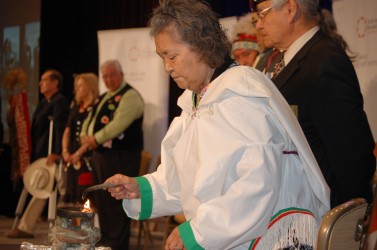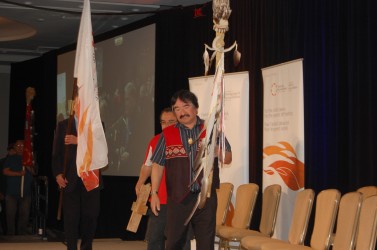Article Origin
Volume
Issue
Year
After six long, hard years of heading the Truth and Reconciliation Commission, Justice Murray Sinclair is tired. But he is also hopeful.
UPDATED PHOTO GALLERY: May 31
UPDATED PHOTO GALLERY: June 1
UPDATED PHOTO GALLERY: June 2
“I believe in the process. What I tell people is you don’t have to believe reconciliation will happen. You have to believe that reconciliation must happen. And I’ve always believed that. And I’m trying to get people to believe the same thing…and that we have an obligation to work to make it happen,” he said.
Sinclair expects the message repeated by the TRC – that reconciliation is a Canadian issue and not an Aboriginal issue – will be underscored by the numbers and make-up of the crowd that marches in Ottawa on May 31 when the TRC kicks off its closing ceremonies.
A similar walk in September 2013, ending the TRC’s national event in Vancouver, attracted more than 7,000 people in the pouring rain. The majority of participants were non-Aboriginal.
“It’s important that everybody understand they have a piece of this, that this is about them as well,” said Sinclair. “So having non-Aboriginal people participate in public processes, such as the walk for reconciliation, is very important and it’s one way they can demonstrate their commitment and willingness to reconciliation.”
The most difficult work undertaken by the TRC, says Sinclair, has been listening to survivors tell their stories. Whether through private statement gatherings or public sharing circles, survivors had to “rip their scars open each time they spoke.”
The TRC provided a safe and secure environment for survivors to share, never challenged their stories, and ensured survivors knew they had been heard. The TRC also travelled to Labrador and Newfoundland, whose five Indian residential schools were not included in the agreement, and listened to day scholars and those who attended Metis residential schools, who were also excluded from the residential school compensation agreement.
“We have made every reasonable effort that we could to get to the survivors and talk to them,” said Sinclair. “I think we did that as well as we could in the time we were given and the resources we were given.”
Survivors, along with their families and community members, will get one last opportunity to talk to commissioners at the closing ceremonies.
The commission has “brought to light” the more than 4,000 children who died at residential schools, said Sinclair, noting that this loss was not contemplated in the settlement agreement. Those children will be remembered on the last day of the closing ceremonies, June 3, with an honouring ceremony and the planting of a Garden of Hearts at Rideau Hall.
These Gardens of Hearts, organized by the First Nation Child and Family Caring Society, KAIROS and Project of Heart, are being created across the country as a legacy to the work of the TRC.
The closing ceremonies will also see another round of honorary witnesses inducted, as well as actions of reconciliation.
“There needs to be a broad-based movement led by prominent citizens and people at the community level to continue to move the issue of the relationship between Aboriginal people and the rest of Canada, particularly the government, forward to a point to where the relationship is much better than it is now,” said Sinclair. He stresses that the government cannot be relied upon to undertake this role as they were the perpetrator.
The movement must identify the process that will be followed to bring about improvements. Sinclair says action needs to include the development of new education curriculum that speaks respectfully to and about Aboriginal peoples; examination of how laws are created, passed, interpreted, and administered; changes to the child welfare system; addressing of social issues in an adequate manner; and advancing of self-determination and self-government for Aboriginal peoples in order to fulfill the treaty-making process.
Sinclair is clear that the reconciliation process must continue and he is not comfortable with leaving it up to the courts to monitor the work that is undertaken. He says that courts focus on legal definitions and not reconciliation.
“And what we are concerned about was that there really should have been more thought given to the ongoing need of the reconciliation process …. This is a political and legal relationship that can’t be terminated. At least not easily. So some process has to be in place on a permanent basis to address the question on what do we do if we can’t agree,” he said.
Sinclair would not elaborate on what that process would look like, saying it will be unveiled as part of the TRC’s final report, which will be delivered June 2. The TRC’s closing ceremonies will take pla
Pce May 31-June 3 in Ottawa.
UPDATED PHOTO GALLERY: May 31
UPDATED PHOTO GALLERY: June 1
UPDATED PHOTO GALLERY: June 2
- 1832 views


